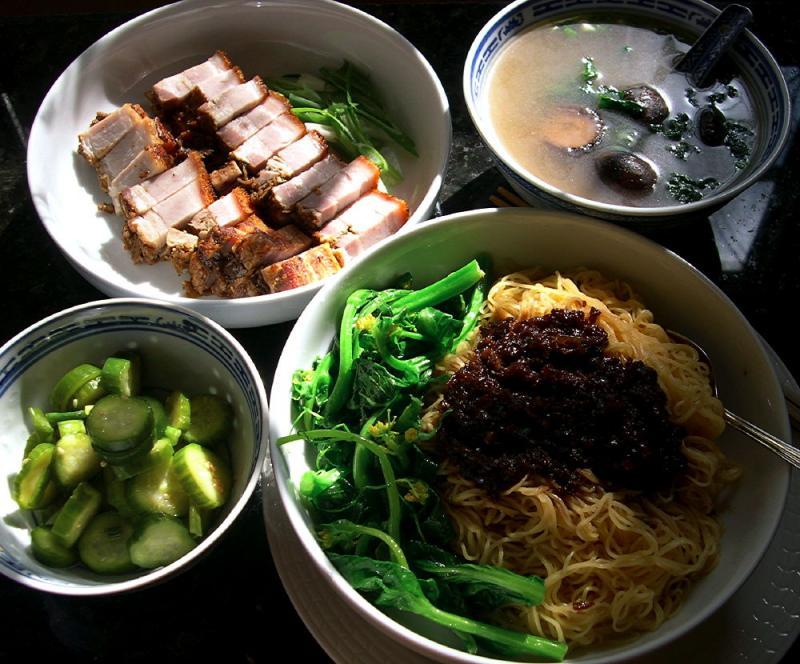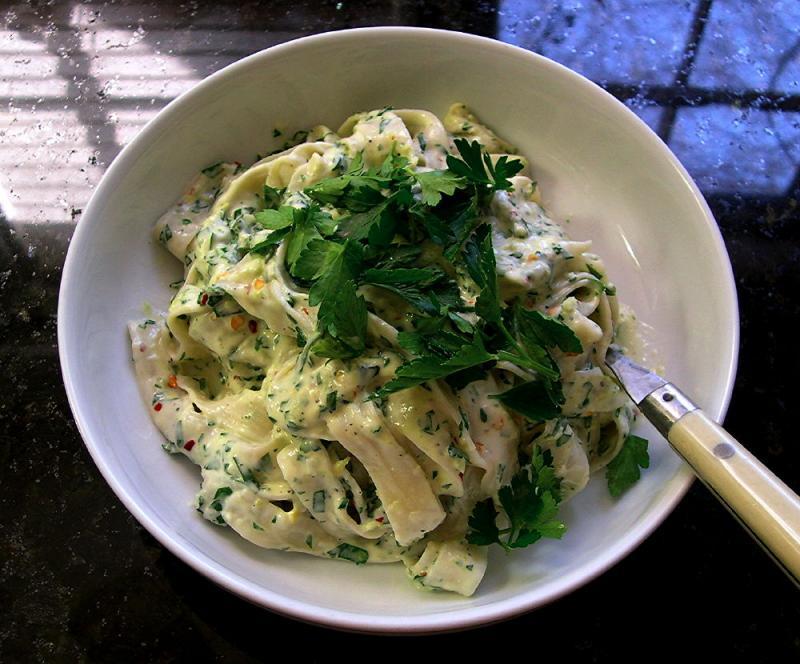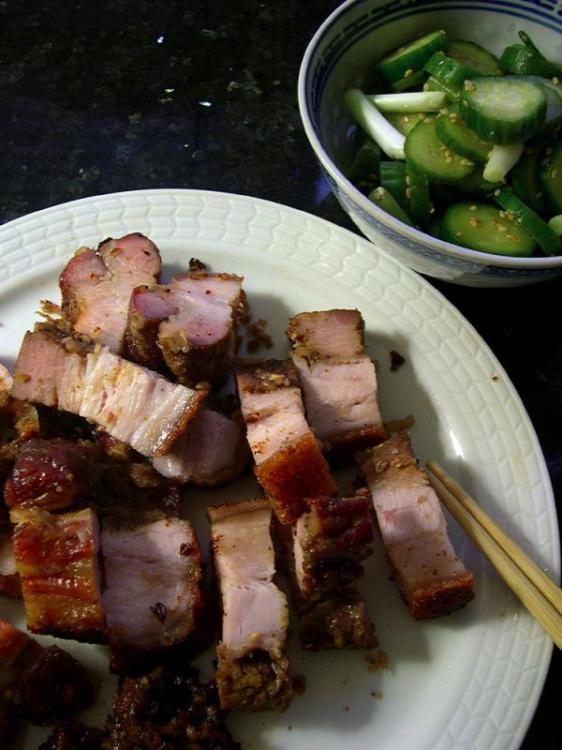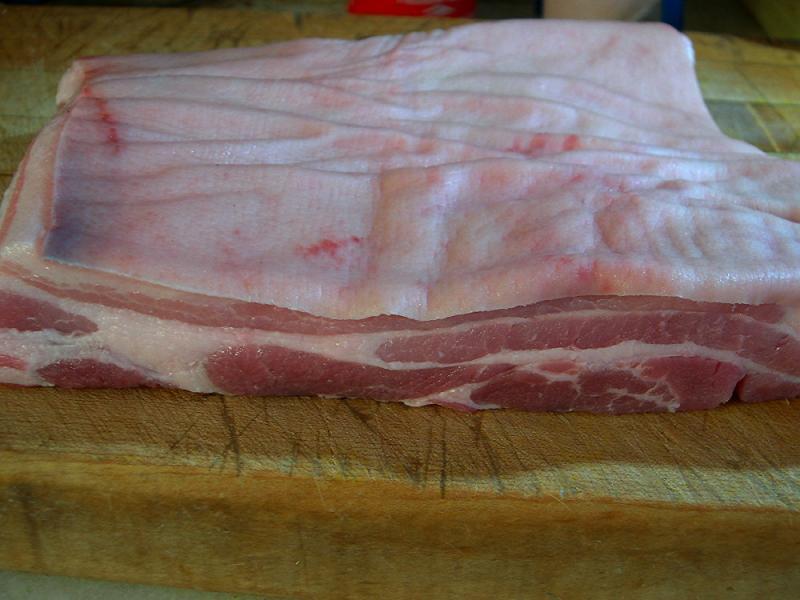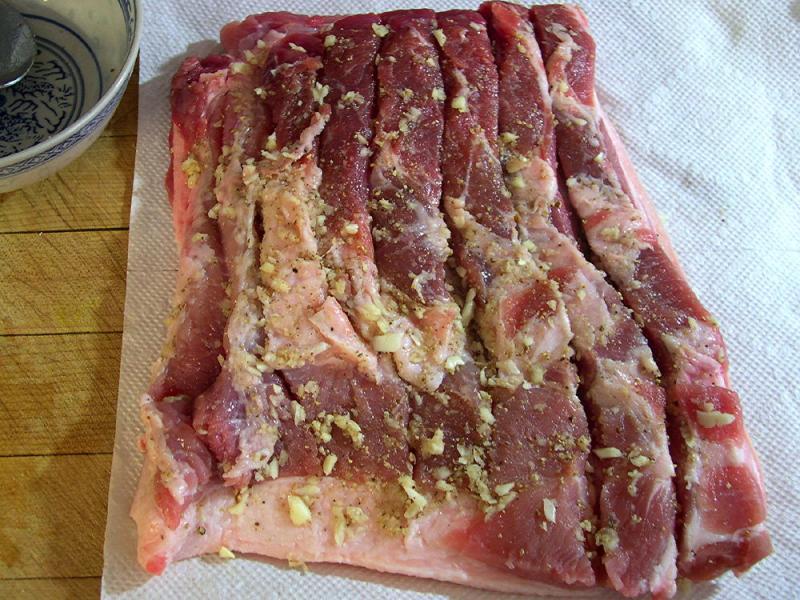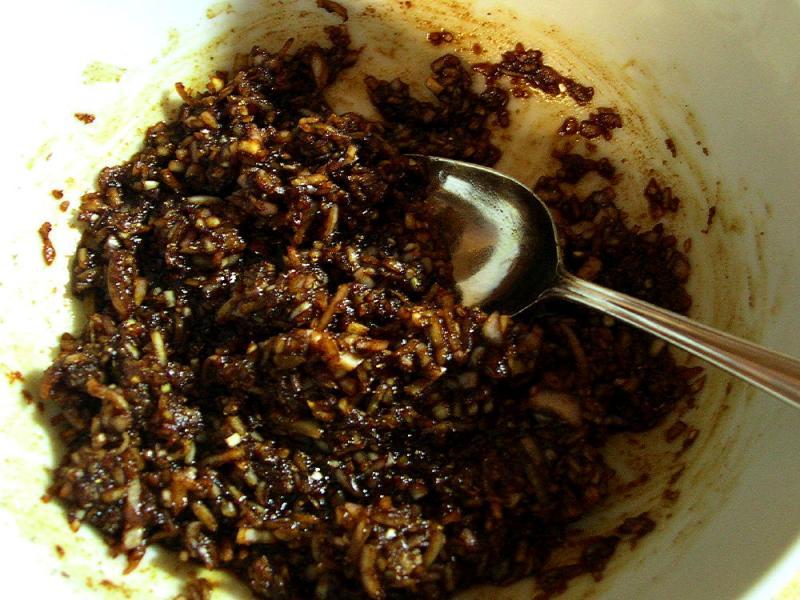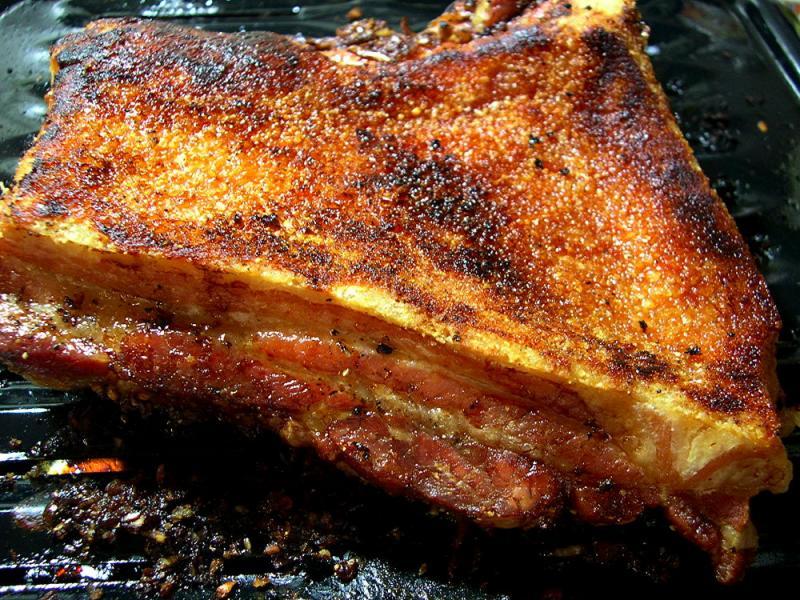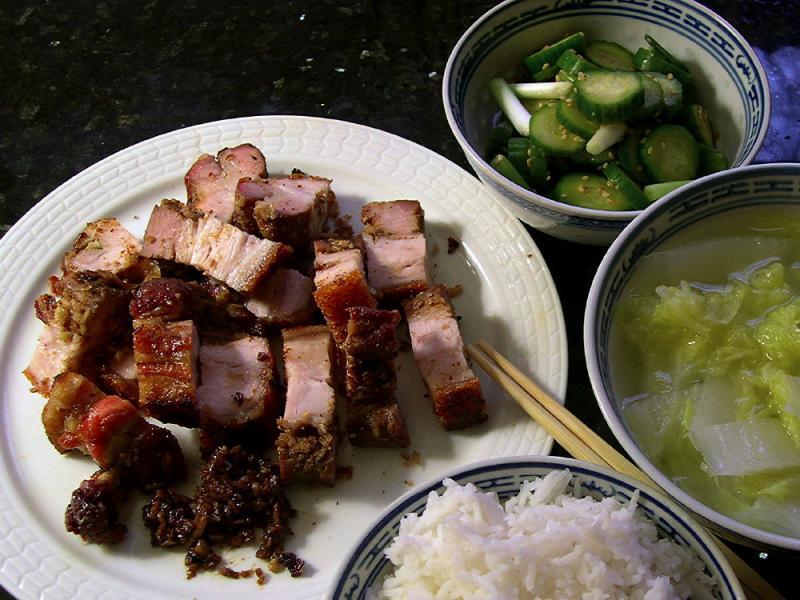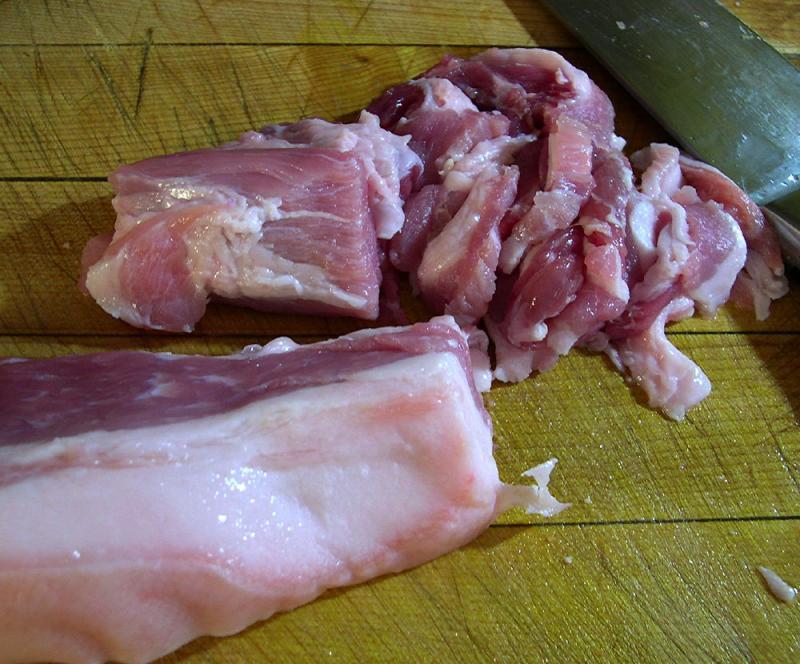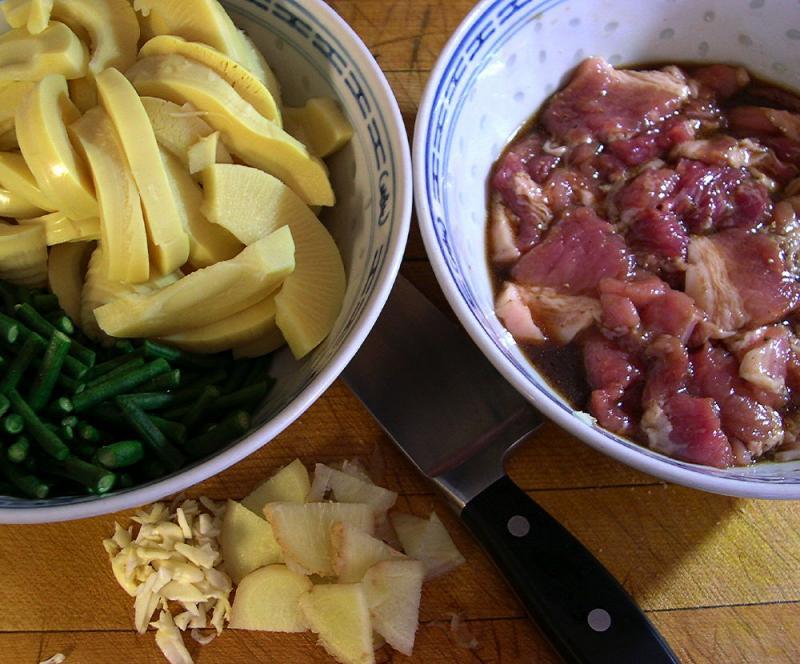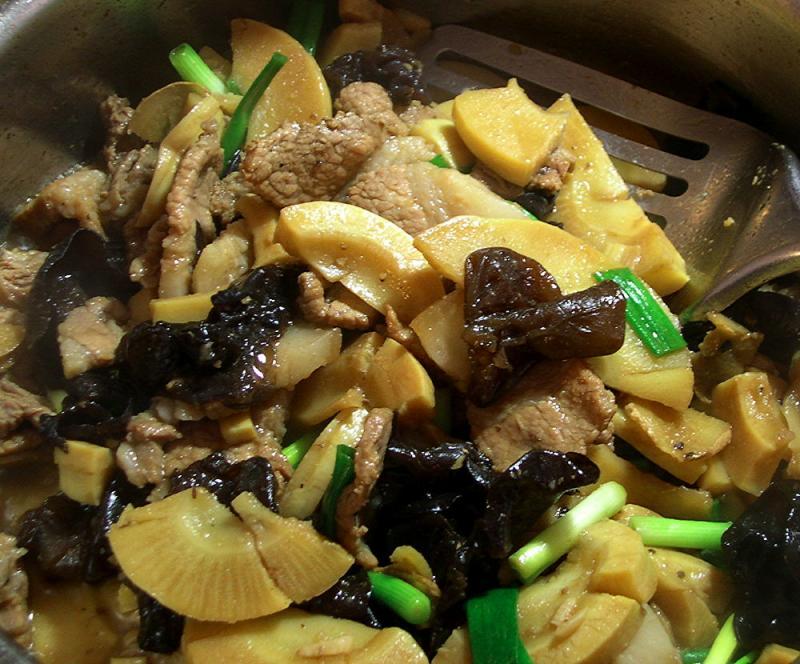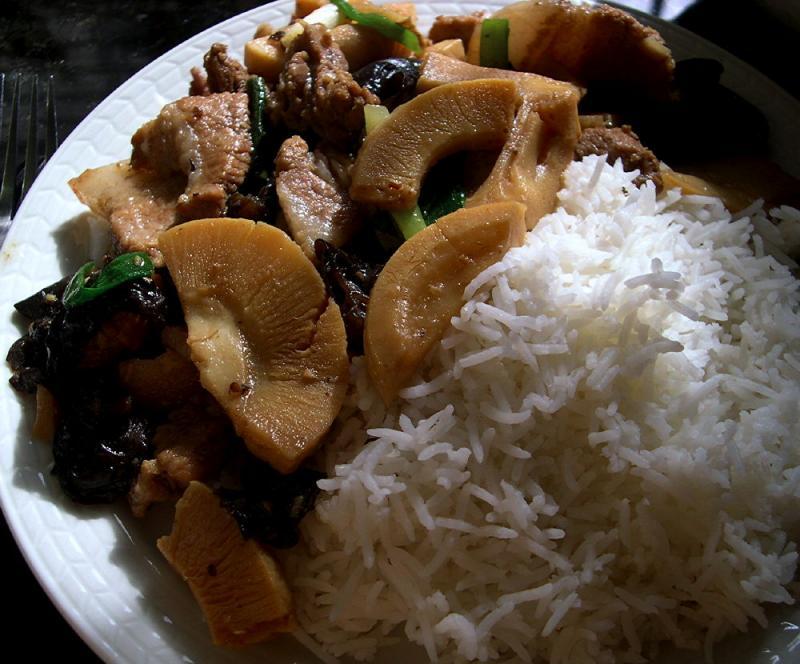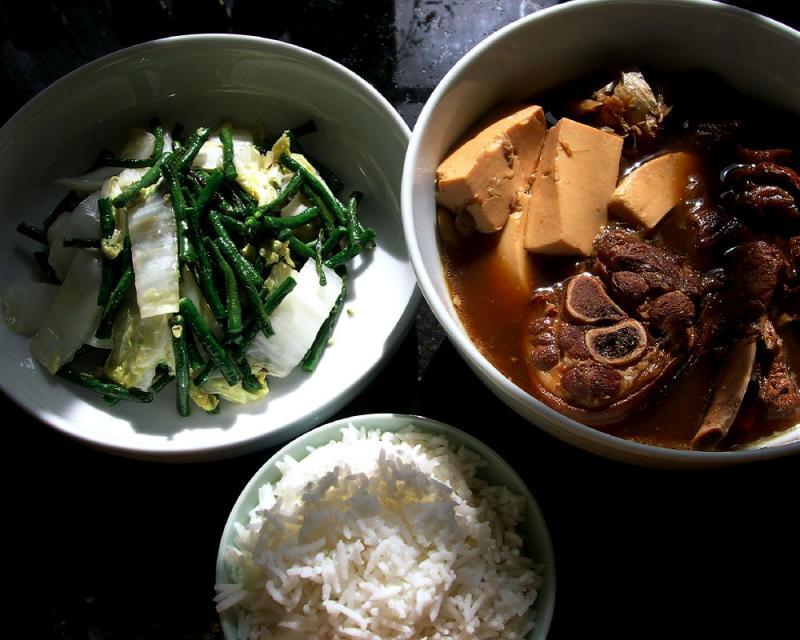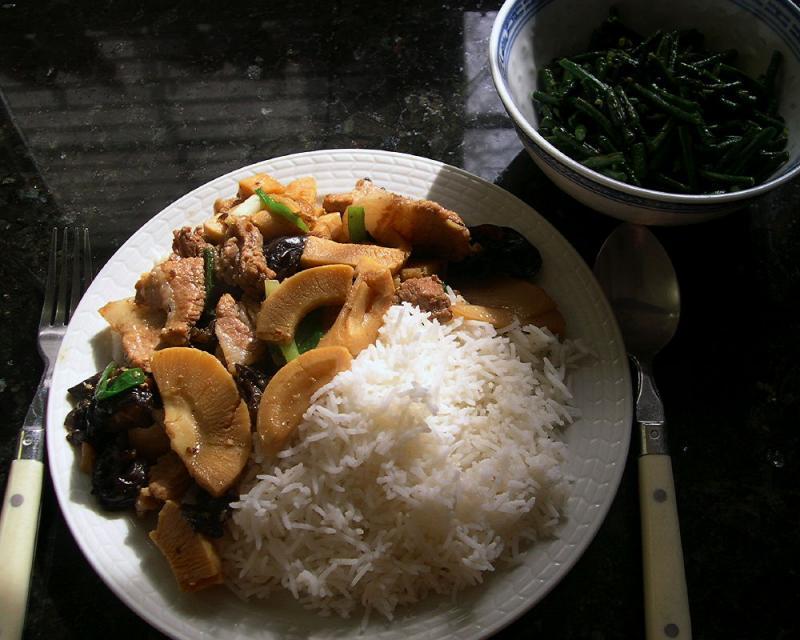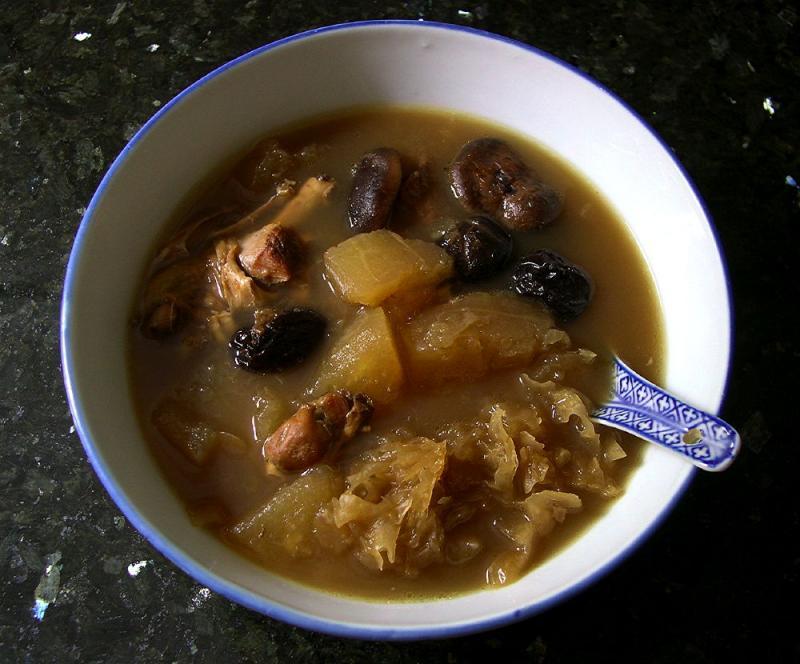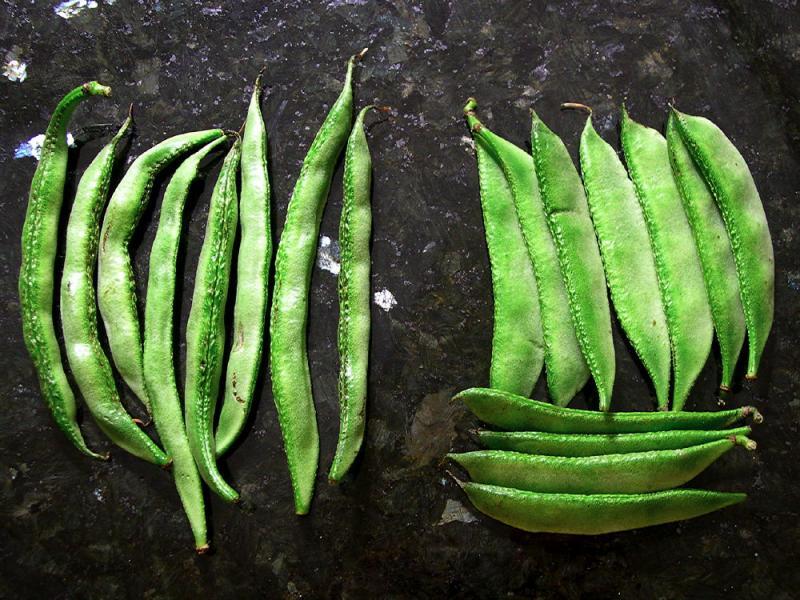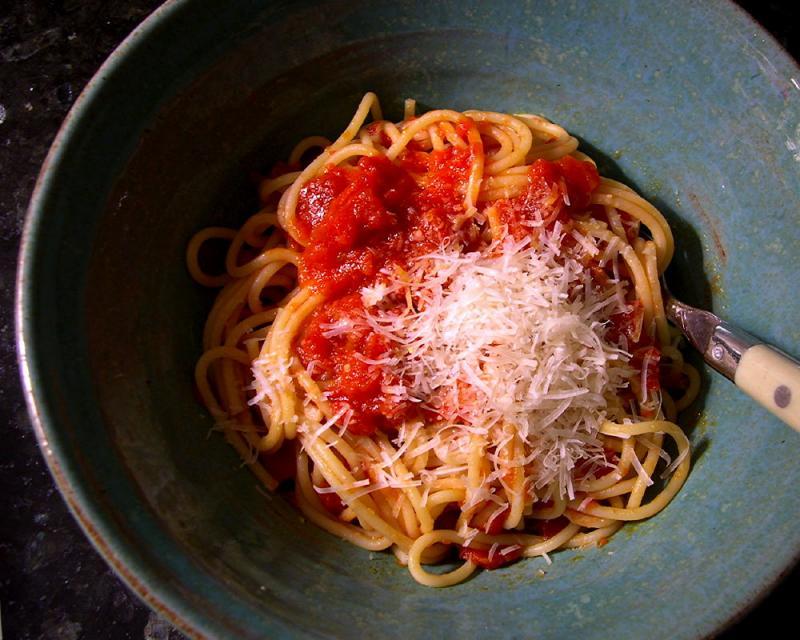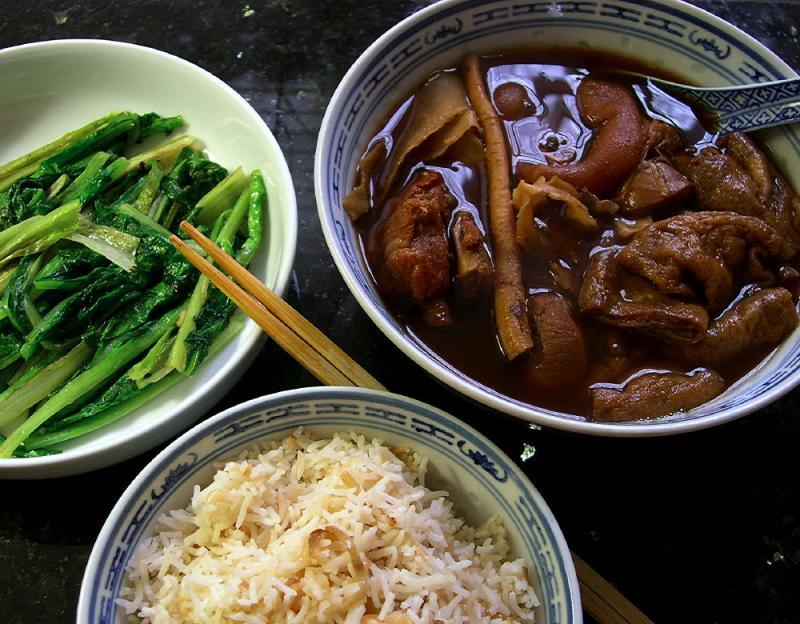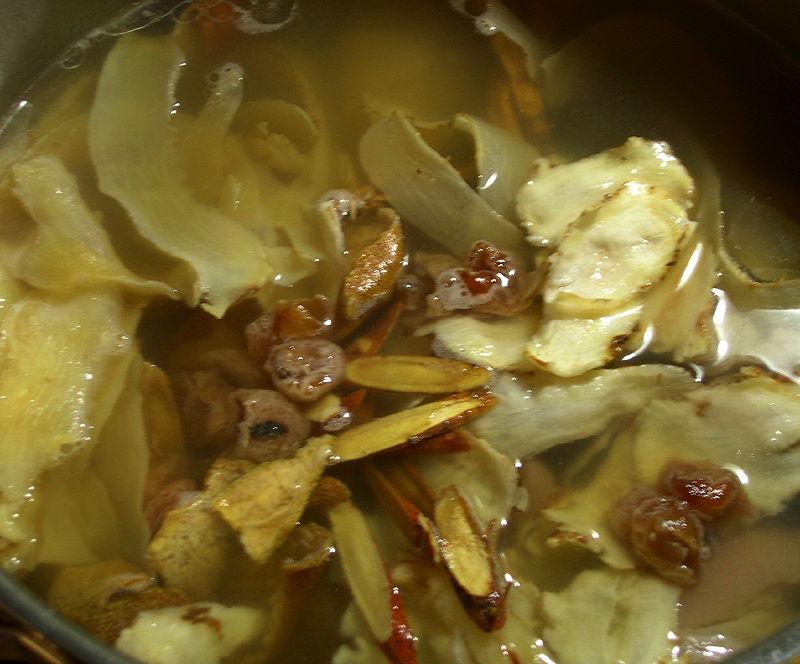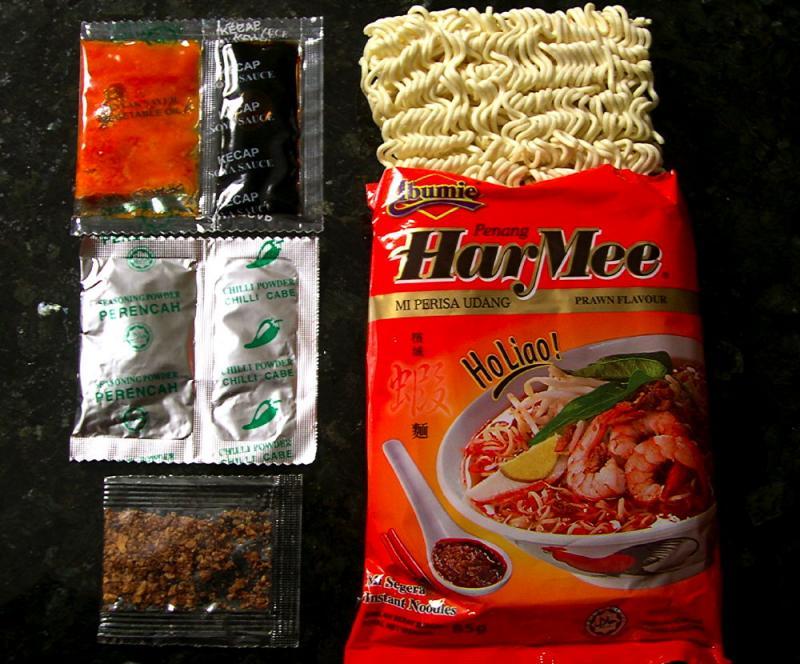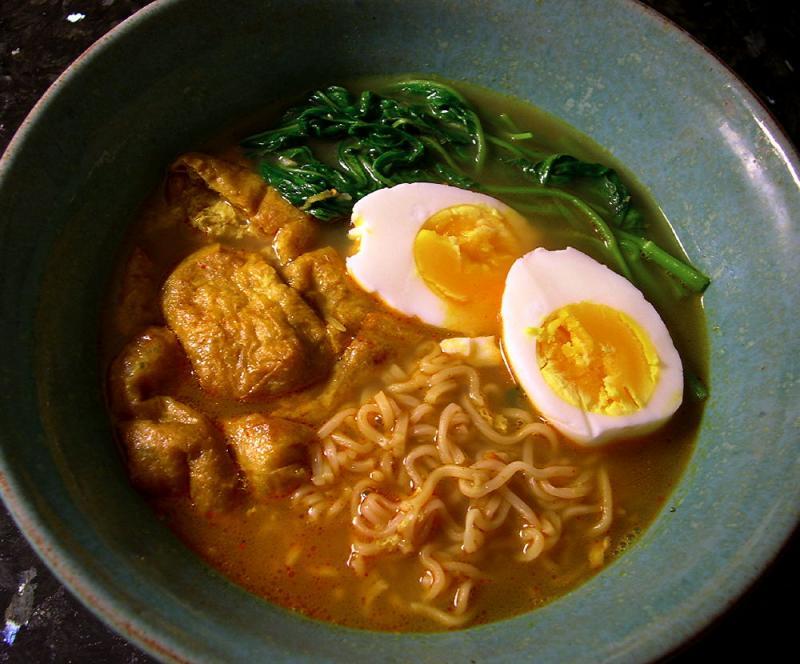-
Posts
3,810 -
Joined
-
Last visited
Content Type
Profiles
Forums
Store
Help Articles
Everything posted by huiray
-
Couple of lunches. ------------------------- • Roast pork, Nyonya-style (one version). • Chicken broth, simmered w/ dried miniature Chinese mushrooms & some de-headed dried ikan bilis, then dressed w/ coriander leaves & chopped scallions. • Pickled scallions & Japanese cucumbers w/ toasted sesame seeds. • Kon Lo Mein, using skinny wonton noodles dressed/tossed w/ the shallot "marinade" left over from preparation of the roast pork (see here) that was sautéed w/ peanut oil & chopped garlic & deglazed w/ some rice wine. • Yu Choy Sum blanched in oiled hot water. ------------------------- • Fresh wide tagliatelle [Nicole-Taylor's] tossed w/ crème fraîche, shaved Parmigiano Reggiano, chopped parsley leaves, grated lemon zest, lemon juice, finely chopped garlic, hot red chili pepper flakes, some olive oil, salt & pepper. Garnished w/ parsley leaves.
-
Have you also seen this? http://www.thepauperedchef.com/2010/04/a-guide-to-bacon-styles-and-how-to-make-proper-british-rashers.html ETA: p.s. Read the comments. Several commentators there corrected some details/nomenclature & what-not in the article itself - e.g. bacon would be far more commonly fried in a pan for a Full Breakfast (in the UK) than grilled (UK)/broiled (US).
-
All herbs, in all their forms! Well, here's one example of the use of certain herbs in the E/SE Asian tradition for one particular dish - more FYI (if you haven't already seen this) as I suspect you would either have little occasion to use them or have difficulty getting them if you wished to try them: http://forums.egullet.org/topic/146914-lunch-whatd-ya-have-2014/page-2?p=1954300#entry1954300 However, one can buy prepackaged mixes of the relevant (and more!) herbs in pouches from large/well-stocked Chinese/"Asian" markets/groceries, rather than the individual herbs (and spices) if one wished to attempt this dish... ;-)
-
http://en.wikipedia.org/wiki/Bacon When I was growing up the only sort of "bacon" I recognized and knew as "bacon" was the equivalent of those "back bacon" slices you show. It was rare that I saw those rashers made from pork belly, and it was thought to be inferior bacon, if it was thought to be bacon at all. It wasn't until I came to the US that I experienced those pork belly rashers of "bacon" as the "default" type of "bacon", with the back bacon being rarer. A cut-and-paste from the Wiki article:
-
Are you asking about strictly fresh herbs and/or herbs used in Western/European cuisine; or are dried/fresh herbs from diverse cuisines included?
-
Thanks, David Ross & Shelby (& Anna N). A comment about what kind of pork belly is desired - I think most folks here prefer meaty cuts, the meatier the better, I suspect. From the perspective of E/SE Asian cooking, a generous amount of fat is commonly preferred, with as many separate intercalating layers as possible being the most prized. Here are two image sets - one for "five flower (pork) meat" (五花肉) and the other for "three layer (pork) meat" (三層肉), both of which are terms for pork belly. If I were to choose from the examples shown in the "five flower meat" set of images, I personally would LOVE to get my hands on this, this, and this - as just three examples. From the "three layer meat" set, three examples I'd snatch up would be this, this and this. Naturally, YMMV. :-)
-
Babi Panggang, with pickled scallions & Japanese cucumbers. (Also plus Napa cabbage in chicken stock & white rice) Fuller description here.
-
A version of Nyonya-style Babi Panggang. Closely after recipe P38 of Irene's Peranakan Recipes. Pork belly piece: Sliced lengthwise, fairly deeply. Slathered w/ a mix of chopped garlic, salt & pepper, rubbed into the slits also. Rested overnight (cold garage). Roasted in medium oven for a short while. Pulled out, skin pricked w/ a sharp pointed paring knife, then broiled under the grill till the skin bubbled/crackled & turned brown. Left it a bit too long (surfing the Net)... Back into the oven for a bit. Pulled again, flipped over, "marinade" of chopped shallots, sugar, dark soy sauce, ground coriander powder, five-spice powder rubbed in. Flipped back over, returned to oven till meat at thickest part was at about 160ºF. "Marinade": After final pull = "done". (Burnt edges scraped off) Chopped up (part of it) and plated; with pickled scallions & Japanese cucumbers, white rice, Napa cabbage in chicken stock.
-
Regarding pork belly prices: At my local Chinese/Asian/International markets/groceries I would say the price hovers in the mid-2 buck per pound range or so. At the full-service butcher I go to on occasion (I get my picanha from them also) their pork belly is around $7/lb, usually 50-50 fat-to-lean or thereabouts. Pork belly is very rare in "normal" Western supermarkets around here. Regarding the "pork belly scrum" mentioned in some posts above - personally, I have never seen such a thing in any of the places I've lived and shopped in.
-
Pork belly stir-fry. Pork belly being sliced up: (Yes, it is pork belly, not some other cut. This was taken off the end of a slab of pork belly I got just the other day; this meaty end also had semi-missing skin due to a partial hack through it during processing at the plant, presumably) Pork belly sliced marinated w/ Shaohsing wine, ryori-shu, mirin-fuu, "aged soy sauce", ground white pepper. Plus some other ingredients - sliced bamboo shoots (large head type), ginger, garlic; also chopped Chinese long beans (stir-fried separately). Stuff in the pan - peanut oil, ginger, garlic, pork belly; toss around; bamboo shoots, then fresh wood-ear fungus (not shown above); toss around; trimmed scallions (not shown above) at the last; seasoning adjusted. Plated, with rice. (The long beans were separately stir-fried and eaten alongside. See here for a pic.)
-
Medium-hot oven for a short while.
-
King oysters are also frequently sliced length-wise and pan-fried w/ a very little oil. See here for an example. They're lovely this way. I like to use the "delicate" variety of oyster mushroom (秀珍菇) (see Liuzhou's link), which I commonly get from my local Chinese grocery, in stir-fries of fresh mushroom medleys; or with other vegetables with or without other mushrooms as well. See here for examples. Also here, here, and here. With the more robust "Phoenix Tail" type (凤尾菇) (see again Liuzhou's link) I prefer to simply stir-fry them alone (i.e. without other mushrooms) with some ginger and scallions, maybe. See here for an example (scroll down to the 8th sub-section/sub-post). I would rarely use butter as the "oil" but that is a personal preference. (I would use butter for fresh chanterelles, OTOH)
-
A couple of recent lunches. ---------------------- Leftover Bak Kut Teh (w/ pork hocks & spare ribs) augmented w/ soft tofu slices; w/ plain white rice and stir-fried long beans & Napa cabbage. ---------------------- • "Stir-fry" of marinated sliced pork belly, garlic, ginger, sliced bamboo shoots (large type), fresh wood-ear fungus & scallions. • Stir-fried long beans. • White rice. Full description in the pork belly topic.
-
I had the impression that caraway seed is thought by at least some Germans (whom I know) to be a "necessary" part of various things - like the sauerkraut accompanying their sausages...stuff like that...and ditto in the cuisine...?
-
A very late simple dinner: Winter melon soup. Made with chicken pieces, pork spare ribs, dried (but rehydrated) Chinese mushrooms (teeny ones plus larger ones (far koo)), dried (but rehydrated) snow fungus, dried oysters, both hung jou and lam jou (two varieties of Chinese jujubes); water, sea salt.
-
I was at an Indian grocery on Saturday and picked up these two bean varieties. The storekeeper identified them (and on the receipt) as round "Valor" beans & flat "Valor" beans respectively. Another lady in the store with whom I spoke identified them as "Sim" beans (she is from Orissa). The internet (and the Wiki article referenced in a previous post) identify Valor beans and Sim beans as synonyms for hyacinth beans and lablab beans, with "Sim" also variously spelled as "Shim", "Sem", etc. while "Valor" beans are also referred to (so it seems) as "Val" beans and other more specific names depending on the region and the variety. (Valor beans Google search) One notes that various varieties are known, due to extensive breeding &etc and certainly exist in both flat and round shapes. Some recipes for these beans: http://sanolisrecipies.blogspot.com/2013/01/runner-beans-shim-bharta.html (flat type, called "shim"; note markings on the spine); http://ushnish.blogspot.com/2009/12/broad-beans-with-coriander-leaves-and.html (flat type, called "sim"); http://www.ahomemakersdiary.com/2011/08/tel-shim-hyacinth-beans-in-mustard.html (flat type, called "shim"); http://chilipaperchains.wordpress.com/2010/04/25/valor-bateta-nu-shak-hyacinth-bean-and-potato-curry/ (round type, with commentary on the name); http://zaiqa.net/category/vegetablestarkariyaan/sword-beanssem-ki-phalli/ (flat type, with commentary on the name); and so on. Another picture showing the round type w/ synonyms for the name also given: http://www.agefotostock.com/en/Stock-Images/Rights-Managed/Y7I-1662543
-

Eating My Way Through the Ecuadorian Fishery
huiray replied to a topic in Central & South America: Cooking & Baking
Darn. Sorry for the folks involved, of course. I imagine their profit margins and livelihoods are slim to begin with and this is definitely not a good thing. Please do report back on what happens next. In the meantime, surely there are other sources of fish in the area, or is this market truly the only one for fresh fish? (Does frozen local fish exist?) -
Thanks, Shelby. Just curious - have you had the "Marcella Hazan" tomato sauce? (If you have please disregard this; or mention that you have indeed have had it)
-
I thought you were anti-soups? :-) But I suppose this one is "thick enough" for you? Looks tasty. What mushrooms were they - the "standard" white mushrooms or something else? Consider mixing in several types of fresh mushrooms next time.
-
Marcella Hazan Tomato Sauce (made using Pomì boxed chopped tomatoes) on spaghetti [Garofalo] w/ some shaved Parmigiano Reggiano.
-

Pronunciation of culinary/food-related terms: Why do it wrong?
huiray replied to a topic in Food Traditions & Culture
Oh, really? Not true. I say "herb" and "bay-sil". Regarding the pronunciation of "(h)erb": http://oald8.oxfordlearnersdictionaries.com/dictionary/herb http://www.macmillandictionary.com/us/pronunciation/british/herb http://answers.yahoo.com/question/index?qid=20111101124159AAg1LPE http://english.stackexchange.com/questions/25410/correct-pronunciation-of-herbs etc etc etc. For my part, I still question why people in the USA have the notion that there is something called "WODDER". I suspect they mean "W-A-T-E-R". Or why some people seem to have this strange name "Scoddy". On checking how they *spell* it it seems they should have said "ScoTTy". Of course, I also still ask folks sometimes for a "s-h-e-d-u-l-e" and sometimes for a "s-k-e-d-u-l-e" depending on which side of the Pond I am mentally in at that moment; or talking about the Boot and Bonnet of my car. I also ask for "turbot", a type of fish, either at the fishmonger or when choosing from a restaurant menu here in the USA, and have to listen to the servers (sometimes the fish counter attendant) ask me if I meant "turbo". There is also this language called 'MURCAN, vaguely related to English, and still mutually comprehensible for the most part to speakers of each, at least for the time being. -
At my local Chinese grocer they come in boxes (chilled/semi-frozen) of slabs around 1 foot x 2 feet in dimensions, ranging from about 1 1/2 to 3 inches thick, of varying meat-to-fat ratios. These folks generally cut them up into strips for sale, but you can get an intact slab or part of a slab if you wish by asking them. Most customers here don't really want intact pieces, they far prefer slices - and as I have exemplified in my posts, that is how most folks use it when cooking pork belly.
-
Some soups from the last two months. • Pork meatballs & daikon in peppery pork stock. • Kale in chicken broth. (scroll down) • Fuzzy melon (a.k.a. Hairy gourd) soup; w/ short-cut pork spare ribs, garlic, cellophane noodles. (scroll down) • Harm Choy Tong w/ chicken legs. (scroll down) • Another version of Harm Choy Tong. • Fish tofu soup w/ garland chrysanthemum, Napa cabbage, white mushrooms, garlic; in chicken stock. (scroll down) • Choy Kon Tong (dehydrated Cole soup). (scroll down) • Soup of pork spare ribs, fresh Chinese mushrooms, snow fungus, daikon, garlic, chicken stock. (scroll down) • Bak Kut Teh (Herbal Hoklo-Canto variety) w/ fried tofu puffs. (scroll down) • Bak Kut Teh w/ pork hocks & pork spare ribs. Heavy herbal treatment & heavy saucing. • Beef shin stew w/ root vegetables. • Angled loofah soup w/ pork spare ribs & snow fungus. • Rice congee cooked w/ pork spare ribs & a form of preserved mustard. (scroll down) • Rice congee w/ sliced pork belly & ja3 choi3. • Slow-simmered chicken broth w/vegetables. (scroll down) Another iteration here; and also here (scroll down). • Cabbage, parsley & garlic soup; chicken stock. (scroll down) • Lotus root soup; w/ chicken & beef, garlic, oil, raw peanuts, lam jou, goji berries, yook chook (Solomon’s Seal rhizome), dried salted oysters, water, salt. • Lotus root soup. With pork short-cut spare ribs, garlic, Chinese jujubes, honey jujubes, goji berries, raw peanuts, dried cuttlefish, sea salt. • A riff on Tachiyama Chanko-Nabe. (scroll down) See also here. • Chanko-Nabe Miso-Aji. Noodle soups, many from dressing up “instant noodle” packs or building upon them: • Pork & cabbage dumplings, poached eggs, skinny wonton noodles in chicken stock, leaf celery, chopped scallions. (scroll down) • “Ho Fan Abalone Chicken Soup Flavored” with sliced Chinese BBQ pork, seafood & cabbage dumplings, and edible chrysanthemum. (scroll down) • “Sau Tao Noodle King Wonton Flavor noodles” w/ lots of chopped scallions & poached eggs. • “Instant Noodles Artificial Hot & Sour Shrimp Flavor” w/ leafy celery leaves & stems, Dodge City salami & Prosciutto Rosa. • “Pickled Cabbage Flavor Instant Vermicelli” w/ leafy celery, pressed tongue & hard-boiled eggs. • Baechu kimchi, bamboo shoots, fried tofu puffs, scallions & garlic soup; with the ho fun plus the soup sachet from a “Ho Fan Abalone Chicken Soup Flavored” package. • “Spicy Kimchi Flavor Bowl Noodle Soup”, w/ white standard mushrooms & trimmed scallions. • “Instant Noodles Artificial Seafood Flavor”, w/ Napa cabbage, poached egg, fish tofu & scallions. • “Myojo Chukazanmai Oriental Flavor ramen” w/ young Tuscan kale, quartered white mushrooms & Chinese roast duck. • “Ibumie Penang Har Mee instant noodle” soup; w/ water spinach, fried tofu puffs & hard-boiled eggs. • “Sour-Hot Flavor Vermicelli”, w/ sliced Debreziner sausage, a few splashes of Chinkiang vinegar, chopped Napa cabbage & scallions. (scroll down) • Beef, veal & celery meatballs; in beef & sautéed garlic stock, w/ chopped curly kale & banh pho noodles. (scroll down) • “Sapporo Ichiban Chicken Flavor Ramen”, w/ standard celery, leafy celery, Chinese roast pork, eggs poached in situ. • Daikon-porkballs-white pepper soup, w/ min6 sin3 (mee sua). • Pork & shrimp wontons & skinny wonton noodles soup, w/ choy sum. Edited to fix formatting.
-
Bak Kut Teh. Today I used both sliced pork hocks (skin on) and pork baby back ribs. Both were subjected to fei sui (飛水; brief parboiling then washing under the tap). The pork hocks were simmered in water w/ a good splash of light soy sauce + some Himalayan salt + 2 heads of garlic w/ all skin/parchment left on, for a while before adding the other stuff in sequence as appropriate. The herbs&etc¶ then went in (today fuller than usual - more stuff, I was in the mood for a heavy more-Klang-like blowout), simmered for a while more. The parboiled pork ribs then went in, simmered for a while. The spices§ then went in; plus sufficient light soy sauce [Pearl River Superior], dark soy sauce [Yuet Heung Yuen], oyster sauce [Lee Kum Kee] to taste and the mixture simmered some more. Previously deep-fried tofu slices (Abura-age) were then tossed in towards the end. Rice was cooked with freshly deep-fried sliced shallots added in. Accompanied by Taiwan A-choy stir-fried w/ garlic in peanut oil. ¶Shaved "Tong Kwai" (當歸; Yale: dong1 gwai1; "Radix Angelica Sinensis"; Angelica sinensis); "Yook Chook" (玉竹; Yale: yuk6 juk1; Polygonatum odoratum (Mill.) Druce); "Chan Pei" (陳皮; Yale: chan4 pei4; dried tangerine peel); “Tong Sam” (黨參; Yale: dong2 sam1 (Codonopsis pilosula 'Nannf') [package as bought is labeled as “正紋党”]; "Kum Chou Peen" (甘草片; Yale: gam1 chou2 pin3; dried liquorice slices, Glycyrrhiza uralensis); dried longan meat (生曬龍眼肉); I skipped the "Hung Jou" (Chinese jujubes) and, later, the "Kei Chee" (Goji berries). § Cinnamon sticks; whole cloves; whole star anise. Pot just after adding in the herbs&etc:
-
A bowl of Ibumie Penang Har Mee instant noodle soup; dressed up w/ kangkong (water spinach), tau fu pok (fried tofu puffs) & hard boiled eggs.


